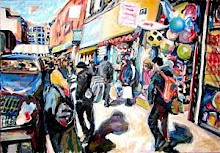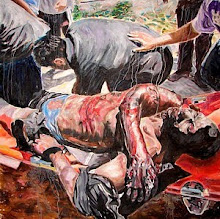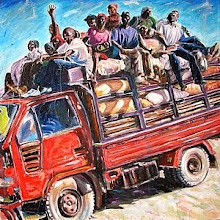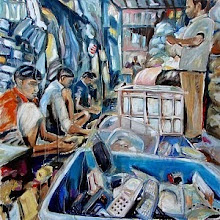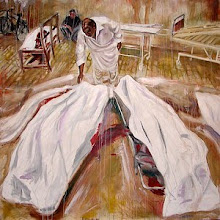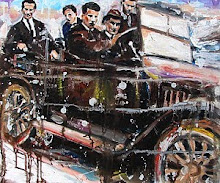By Caoimhghin Ó Croidheáin
Despite all the contemporary global interconnectedness, the lack of an international social consciousness among artists (whose work is linked only by its sameness and market-ready designs and styles) evokes frustration in the politically conscious critic and commentator. As Andre Vltchek wrote after a recent trip to Paris:
"Galleries exhibit endless lines and squares, all imaginable shapes and colors. In several galleries, I observe abstract, Pollock-style ‘art’. I ask owners of the galleries, whether they know about some exhibitions that are concentrating on the plight of tens of thousands of homeless people who are barely surviving the harsh Parisian winter. Are there painters and photographers exposing monstrous slums under the highway and railroad bridges? And what about French military and intelligence adventures in Africa, those that are ruining millions of human lives? Are there artists who are fighting against France becoming one of the leading centers of the Empire? […] No new symphonies or operas dedicated to the victims of Papua, Kashmir, Palestine, Libya, Mali, Somalia, the Democratic Republic of Congo, or Iraq."[1]

Crisis? What Crisis? by Caoimhghin Ó Croidheáin
Triptych / Oil on canvas / 60cm x 180cm / 23.6 in x 70.6 in
The difficulties of creating a socially conscious art are revealed in the comments by Jim Fitzpatrick, a contemporary Irish artist with an internationalist outlook who is well known for his iconic two-tone portrait of Che Guevara created in 1968 and which was based on a photo by Alberto Korda.[2] Fitzpatrick’s internationalist consciousness is evident in his early awareness of Che’s revolutionary activities:
"I was very inspired by Che's trip to Bolivia. He went there with the intent to overthrow the intensely corrupt government, helped by the Americans at the time, and that's where he died. I thought he was one of the greatest men who ever lived and I still do in many ways."[3]
Fitzpatrick met Che in the Royal Marine Hotel bar in Kilkee, Co Clare, in the summer of 1961 and his description of their meeting highlights the reciprocity of international consciousness:
“We talked for a few minutes once he realised that I knew who he was. His English was faltering, but he could make himself understood. The first thing he said was, ‘You know I’m Irish. My father was Guevara Lynch.’ I was taken aback by that because I didn’t know that at all.”[…] “Che read his James Joyce. When he was a young lad he began keeping a philosophical dictionary. He didn’t write or speak much about the Irish rebellion, but it’s my understanding that he was certainly aware of it, and aware of the idea of the Irish rebel, which appealed to him very much."[4]

9/11 Mystery Play by Caoimhghin Ó Croidheáin
Triptych / Oil on canvas / 60cm x 180cm / 23.6 in x 70.6 in
Fitzpatrick’s poster of Che was published in 1968 and immediately ran into trouble:
"Every shop that stocked the poster was threatened or harassed: in the very fashionable Brown Thomas of Grafton Street [Dublin], which sold cards and posters in those faraway days, a well-turned out lady bought the entire stock, tore them all to pieces in front of the astonished staff and walked out!"[5]
Despite the fame and notoriety in certain quarters the poster brought him over the years, his influence over younger artists was countered by state conservatives:
"The artist himself tells the story of a conversation he had at a party many years ago with the then president of the National College of Art and Design in Dublin: "You probably don't know this, but every year at least half the candidates for placement in the college have portfolios that show the huge influence your work has on the younger artists of this country...." "Quite right," said Fitzpatrick, feeling slightly gratified at such a great compliment, “I had absolutely no idea; what do you do with them all?" "Oh, we just fuck them all out!"[6]

Gaza Ambulance by Caoimhghin Ó Croidheáin
Triptych / Oil on canvas / 60cm x 180cm / 23.6 in x 70.6 in
The difficulties of doing international political art are well described by the American artist, Leon Golub (1922 – 2004). Much of Golub’s work covered themes such as racial inequality, oppression, exclusion, and violent aggression. In one interview he stated:
"I was attempting a kind of heroic/antiheroic public art. The kind of thing which is emblazoned in a big way on the walls of a culture. Take, for example, "Interrogations"- a painting that is 10 by 14 feet. Perhaps that's not public art in the conventional sense as torture scenes are usually hidden from view and are not ordinarily celebrated on public walls. At the same time it is an ordinary fact that in many countries torture is a day-to-day reality, people are yanked off the streets, jailed, and tortured. In that sense, to put out an Interrogation is to make a public statement. Even if the statement has to stay in a studio - if you're lucky, end up in a museum. Even a museum might be reluctant to acquire one."[7]
Golub describes his methodology:
"I'm always on the hunt for source material. I have a huge collection of photographs as I've been doing this for many years. […] In the earlier works, for example, the Vietnam paintings, typically although not invariably, the figures were not projectively imagined; they're taken from photographs, partially varied but basically whole. More recently a figure will be constructed from many source photos, partly as I want to make it my own and partly because I can be more dramatically effective. This guy who's smiling with the flag on his chest, I don't have a head just like his but I have a number of heads of guys smiling in somewhat similar fashion and I work it out that way."[8]

Odessa by Caoimhghin Ó Croidheáin
Diptych / Oil on canvas / 60cm x 120cm / 23.6 in x 47 in
It is in the desire to create an international art that the aesthetic principles of Social Realism [witnessing/painting local people/situations] begin to break down. It is not always possible to be a witness to international events so source material has to be found using other means. Today the internet is used by many artists in the same way as journalists as a basis for research.
While Golub collected visual material from many different sources some artists work directly with people in difficult situations. Another contemporary Irish artist, Brian Maguire, produces paintings which cover many subjects from around the world. His work reveals a strong social conscience, tackling many difficult situations that do not always get the attention of the main-stream media. One project covered the deaths of thousands of women slain at the hands of drug cartels in the Mexican city of Juárez:
"The killing campaign in Mexico has taken the lives of more than 1,400 young women since 1994, mainly factory girls working in maquiladoras, sweatshops of sorts, who were abducted around town. Maguire spent time with the victim's mothers, discussing their daughter's lives and premature deaths, before beginning to paint two portraits of each victim: one representing the young girl during her life and another, after death.[…] “You have to bring some value to the place and people, which gives you the right to work there […] For a start, I can take their story outside Mexico, and tell it to Europe…I can campaign for them by showing my paintings in museums.”"[9]
Making art with an international social consciousness maybe an uphill struggle for many artists but it gives the artist an important role in the struggles of many ordinary people while at the same time showing that art can be a voice for the expression of the many in the face of adversity. Furthermore, taking stories outside of their original contexts reveals to many others the similarities of distant situations, often connected by the same globalist entities.
[1] See: http://www.counterpunch.org/2015/03/20/the-collapse-of-french-intellectual-diversity/
[2] http://en.wikipedia.org/wiki/Jim_Fitzpatrick_%28artist%29
[3] http://en.wikipedia.org/wiki/Guerrillero_Heroico
[4] http://www.irishexaminer.com/lifestyle/features/jim-fitzpatrick-and-che-guevara-inspired-by-irish-rebels-288646.html
[5] http://www.insideyourart.com/artists/Jim-Fitzpatrick
[6] http://www.insideyourart.com/artists/Jim-Fitzpatrick
[7] http://www.no-art.info/golub/interview-en.html
[8] http://www.no-art.info/golub/interview-en.html
[9] http://news.artnet.com/art-world/art-show-at-fergus-mccaffrey-inspired-by-murder-of-1400-women-in-juarez-270800/
Caoimhghin Ó Croidheáin is an Irish artist who has exhibited widely around Ireland. His work consists of paintings based on cityscapes of Dublin, Irish history and geopolitical themes (http://gaelart.net/). His blog of critical writing based on cinema, art and politics along with research on a database of Realist and Social Realist art from around the world can be viewed country by country at http://gaelart.blogspot.ie/.
